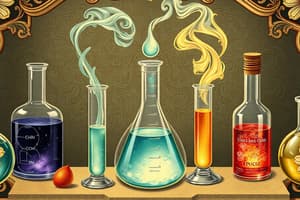Podcast
Questions and Answers
What does the law of conservation of mass state?
What does the law of conservation of mass state?
- Mass can be destroyed.
- Mass is neither destroyed nor created during chemical or physical reactions. (correct)
- Mass varies based on the size of the sample.
- Mass is created during chemical reactions.
What is the law of definite proportions?
What is the law of definite proportions?
A chemical compound contains the same elements in exactly the same proportions by mass regardless of the size of the sample or source of the compound.
What does the law of multiple proportions state?
What does the law of multiple proportions state?
If two or more different compounds are composed of the same two elements, then the ratio of the masses of the second element combined with a certain mass of the first element is always a ratio of small whole numbers.
What is an atom?
What is an atom?
Nuclear forces are short-range proton-neutron, proton-proton, and neutron-neutron forces that hold the nuclear particles together and are referred to as ________ ________.
Nuclear forces are short-range proton-neutron, proton-proton, and neutron-neutron forces that hold the nuclear particles together and are referred to as ________ ________.
What is an atomic mass unit (amu)?
What is an atomic mass unit (amu)?
What does the atomic number represent?
What does the atomic number represent?
What is average atomic mass?
What is average atomic mass?
What is Avogadro's number?
What is Avogadro's number?
What defines an isotope?
What defines an isotope?
What is the mass number?
What is the mass number?
What is molar mass?
What is molar mass?
What is a mole?
What is a mole?
What is a nuclide?
What is a nuclide?
Match the following scientists with their contributions:
Match the following scientists with their contributions:
What was the gold foil experiment?
What was the gold foil experiment?
What is a cathode?
What is a cathode?
What is an anode?
What is an anode?
What did investigators notice during the cathode ray experiment?
What did investigators notice during the cathode ray experiment?
What did Aristotle believe about atoms?
What did Aristotle believe about atoms?
What is a chemical reaction?
What is a chemical reaction?
What is the nucleus of an atom?
What is the nucleus of an atom?
Define a neutron.
Define a neutron.
Define a proton.
Define a proton.
Define an electron.
Define an electron.
What are subatomic particles?
What are subatomic particles?
What are alpha particles?
What are alpha particles?
Why did they expect the alpha particles to pass straight through the gold foil?
Why did they expect the alpha particles to pass straight through the gold foil?
What is hyphen notation?
What is hyphen notation?
What is a nuclear symbol?
What is a nuclear symbol?
The number of neutrons is calculated by mass number - atomic number = ________.
The number of neutrons is calculated by mass number - atomic number = ________.
Flashcards are hidden until you start studying
Study Notes
Fundamental Laws of Chemistry
- Law of Conservation of Mass: Mass is conserved during chemical and physical reactions; it cannot be created or destroyed.
- Law of Definite Proportions: A chemical compound has a constant composition by mass, regardless of sample size or source.
- Law of Multiple Proportions: When two elements form different compounds, the mass ratios of the second element combined with a fixed mass of the first element are simple whole numbers.
Atomic Structure
- Atom: The smallest unit of an element that retains its chemical properties.
- Atomic Number: Represents the number of protons in an atom's nucleus, defining the element.
- Mass Number: The total count of protons and neutrons in an atom's nucleus.
- Isotope: Atoms of the same element with varying masses due to differing neutron counts.
Particle Mass and Measurement
- Atomic Mass Unit (amu): Defined as 1/12 the mass of a carbon-12 atom.
- Average Atomic Mass: The weighted average of an element’s isotopes based on their natural abundance.
- Molar Mass: The mass of one mole of a substance, expressed in grams per mole (g/mol).
- Avogadro's Number: The number of particles in one mole of a substance, approximately 6.022 x 10²³.
Subatomic Particles
- Neutrons, Electrons, Protons: The three main types of subatomic particles; neutrons are neutral, protons are positively charged, and electrons are negatively charged.
- Nucleus: A small, dense region at an atom’s center, containing protons and usually neutrons.
- Nuclear Forces: Short-range forces that unite protons and neutrons within the nucleus.
Historical Perspectives on Atomic Theory
- Dalton's Atomic Theory: Basic principles include the belief that all matter is made of atoms, elements consist of identical atoms, and atoms combine in simple ratios. Original components also contained misconceptions about atom divisibility.
- Modern Atomic Theory: Acknowledges the divisibility of atoms into smaller particles and that isotopes of an element may exhibit different masses.
- Democritus: Proposed the concept of indivisible atoms as the fundamental building blocks of matter.
- Aristotle: Dismissed atomic theory, asserting that matter was continuous.
Key Experiments and Discoveries
- Thompson's Experiment: Identified the existence of electrons, showcasing their significant charge in comparison to mass.
- Millikan's Oil Drop Experiment: Measured the mass of an electron and confirmed its negative charge.
- Rutherford’s Gold Foil Experiment: Demonstrated that atoms have a dense, positively charged nucleus as alpha particles were deflected unexpectedly.
Chemical Changes and Reactions
- Chemical Reaction: A process where substances transform into new substances through rearrangement of atoms.
- Cathode Ray Experiment: Revealed that cathode rays are composed of negatively charged particles.
- Alpha Particles: Positively charged particles, each with four times the mass of a hydrogen atom.
Nomenclature and Symbols
- Hyphen Notation: Indicates isotopes using the format "element-mass number" (e.g., uranium-235).
- Nuclear Symbol: Utilizes a superscript for mass number and a subscript for atomic number to represent isotopes (e.g., ²³⁵/₉₂ U).
Calculation of Neutrons
- Number of Neutrons: Calculated by subtracting the atomic number from the mass number (mass number - atomic number).
Studying That Suits You
Use AI to generate personalized quizzes and flashcards to suit your learning preferences.




